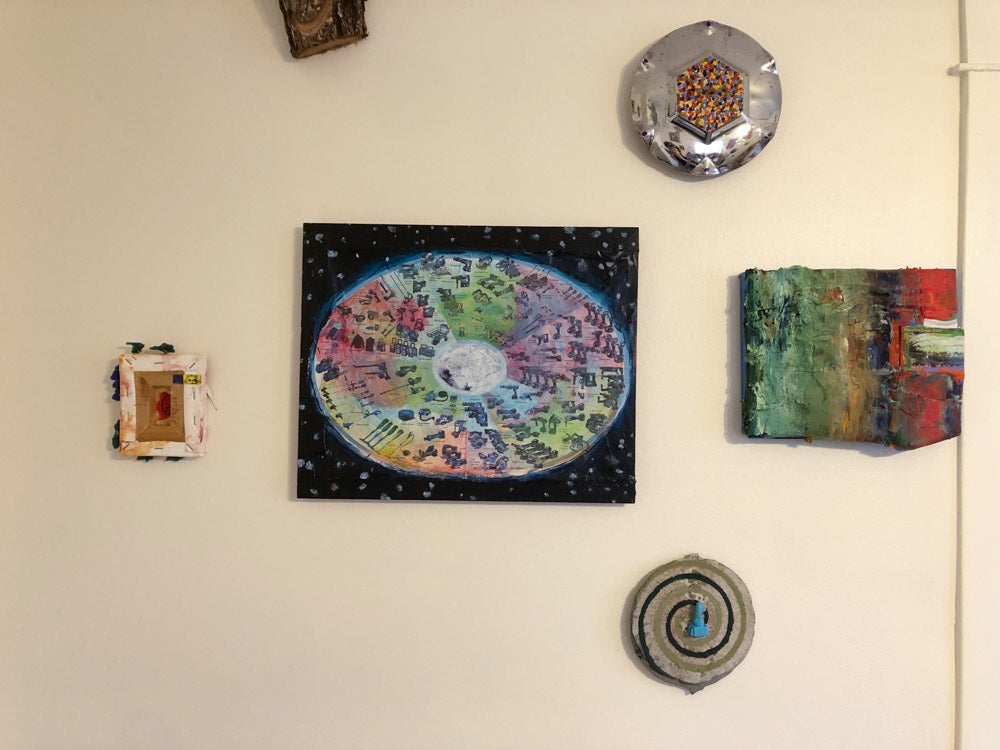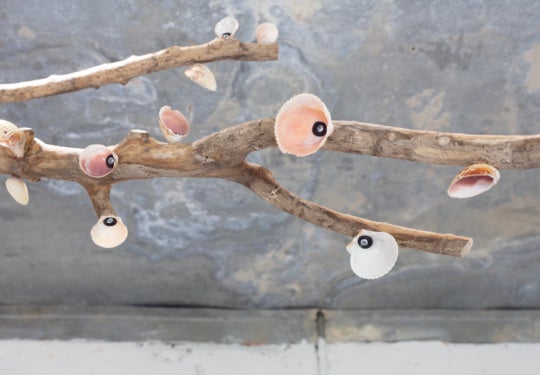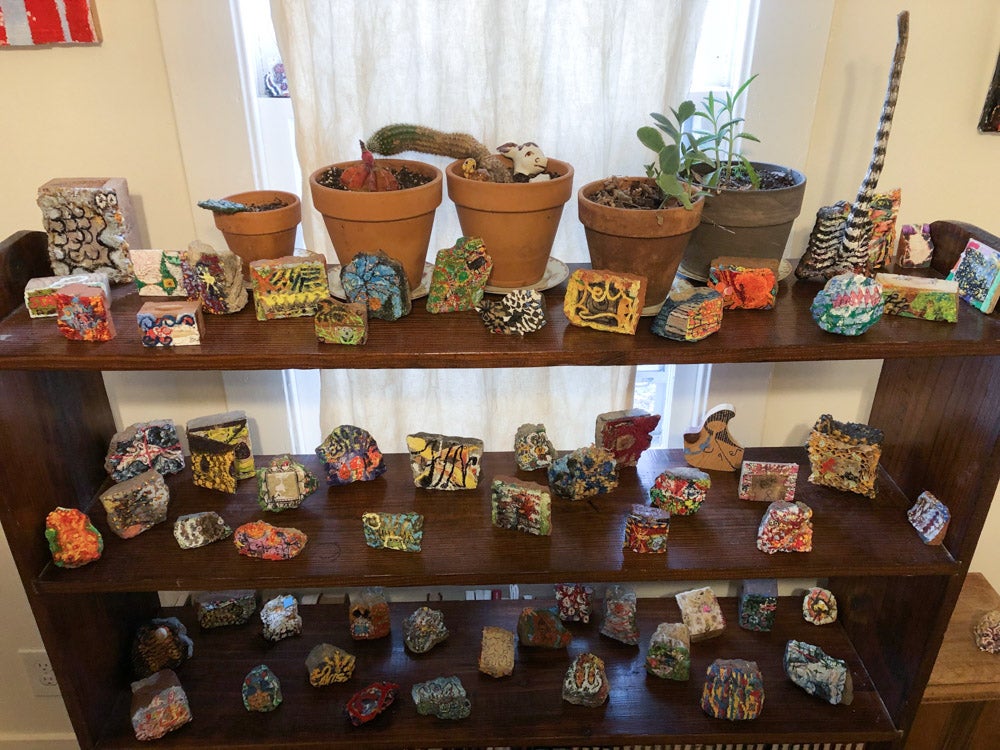
As I sit down to write this, I’m looking at the small assemblage I acquired from Alex Kimball a few months ago. It’s composed of a mysterious, thin surface fastened to a plastic carton, dabbed with thick paint and garnished with two dried walnut shells. The brittle, artificial plastic compliments the synthetic blues and pinks of the paint; a wooden scrap peeks through the circular openings in the surface. There’s something delightful about the novelty of the combined objects, a playful yet intentional quality that continuously draws one in.
I met Kimball—as one often does these days—through Instagram, after seeing his work reposted by a friend of a friend. Scrolling through his feed, my eyes bounced from piece to piece, each colorful, energetic, and unrepeatable. Wooden scraps, thread, globs of paint, fabric, photographs, metal hardware, stones, beads, pinecones, toy cars—anything can become a part of Kimball’s “paintings.” Collected throughout his day to day, on walks or elsewhere, these objects serve as notes from the quotidian, reflecting greater curiosities. The resulting assemblages are the result of movement, collection, and meditation.
In Kimball’s studio, artwork lines the shelves and floors as though part of some strange library. A paint-smeared rectangle of carpet lies in the center of the room, covered with works in progress and an unpredictable assortment of materials. Earnest and thoughtful, Kimball talks me through his practice, our conversation covering everything from his Stan Brakhage recommendations to the aesthetic intricacies of garbage. Not unlike his artwork, Kimball’s disposition leaves one feeling curious, refreshed, and hopeful.
Maria Owen: Your studio is filled with miscellaneous objects that ultimately are assembled into artworks. Can you tell me a bit about this process? Where do the materials come from, and how do you go about making something?
Alex Kimball: It is a mysterious process to me. I usually collect raw materials on walks, or adopt things around the house that have lost their original use because they are “broken.” Sometimes, people who know I am interested in fragments will gift them to me. I don’t always know why it is that I am drawn to the things I collect, and I like this loss of agency. I like when others give me things that I don’t have an obvious fondness for. Something can then happen in the process of making and being with these things where a deeply spontaneous relation is shifted into a meditation. The thing then begins to open itself up. Eventually, if a painting is going really well, it makes me laugh. It surprises me. I become mystified by it and the world seems really enchanted.
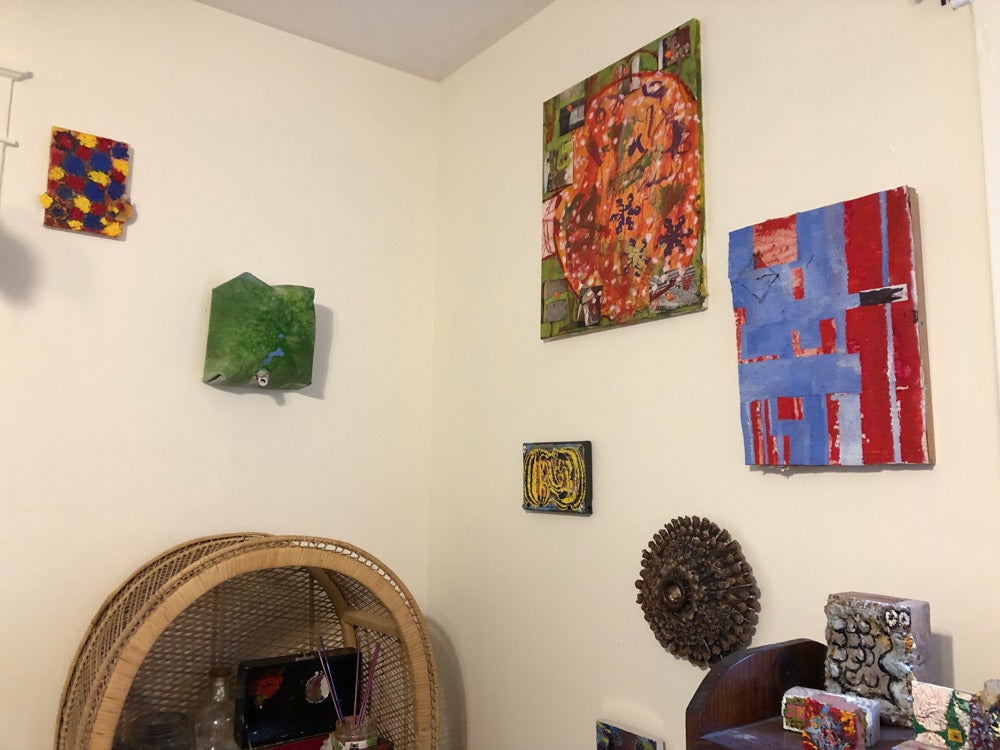
MO: That’s a beautiful way of seeing. Is there a particular item in the studio at the moment that you’re lost in interpreting?
AK: One artifact that I’m spending a lot of time with right now is a rubber ball—it was probably a dog toy at one point. I had incorporated it into a painting over a year ago, but it was grudgingly attached to that work’s surface. I think it’s happier being a full entity in itself, and not an ornamentation on a canvas. Sometimes it takes time to realize what things want to be. Now, it is folded and sealed in a way that makes it resemble a hand; preexisting creases in it serendipitously form the major wrinkles of a palm. We’ll see where it goes from here!
MO: The nature of some of these objects brings me to my next question: though your process involves found materials that wouldn’t generally be considered “natural,” nature and the Earth are inherent to your work. How do you reconcile these aspects of your practice? What do you think they reveal?
AK: Nature is a term of separation. It functions as an object that we, the subject, may observe. I am very wary of the typical “hike” and other nature-oriented activities. They parcel out reality into different spheres. For example, there is a path, and it goes through a reserve with a boundary that was set by humans for non-human life; you can look and vacation there. To me, it is exciting to abandon the concept of nature. I am interested in ecology as a kind of susceptibility. When I am collecting and making, and the resonating chord strikes, my compassion for the thing becomes so vibrant that “I” seem to disappear. Inside and outside become fuzzy. There are no clear boundaries in life, we are porous and Earth is porous, and our guts are filled with millions of bacteria coevolving with us. That excites me.
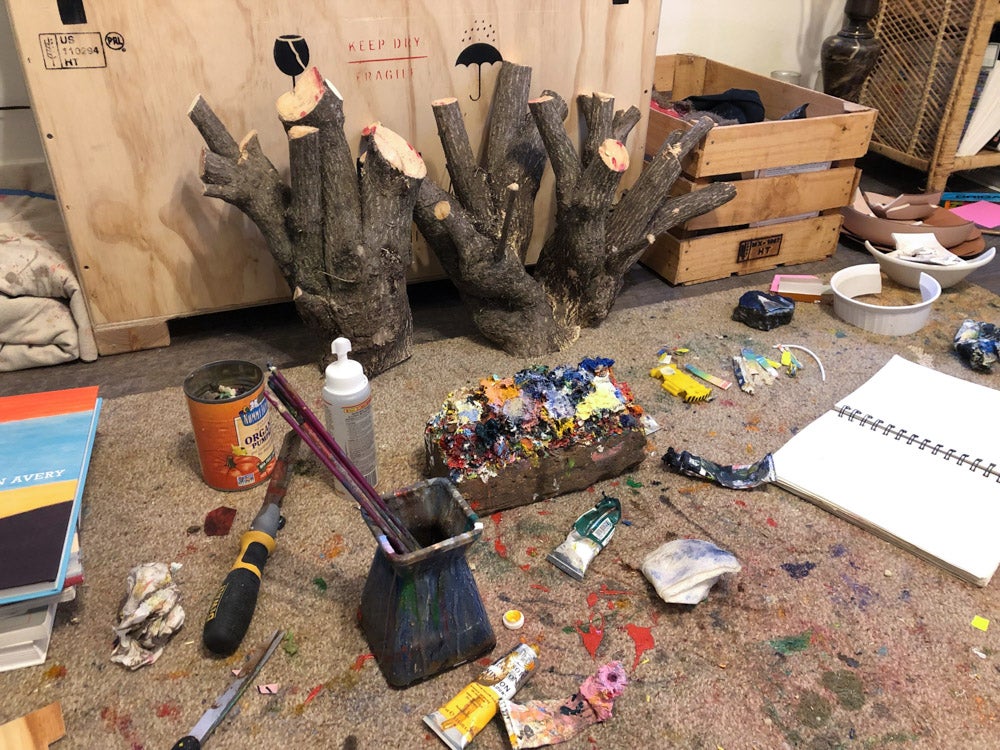
MO: In that vein of expansion, what are you thinking about and consuming outside of artmaking? Books, films, podcasts, music, experiences, practices, etc.?
AK: Where to begin! I love digging. Most recently, I’ve been reading Paracelcus’ writing on nymphs, sylphs, pygmies, and salamanders. Ibn al Arabi has been someone I’ve kept returning to for the past year. Jorge Luis Borges and his Book of Imaginary Beings is great, too; I always find inspiration there. As far as music goes, I’ve been really digging a curious album called Avant Garde by Damian and the Criterions. It’s really kitschy and awesome and the first song sounds like a demented carnival where he’s singing about bread and maybe other stuff, but I can’t tell what the words are at all. I also listen to a lot of new age when I don’t want to be distracted by words. Don Cherry and Caroliner are always on my mind. I love the way they each engage with total art—costumes, uncommon instruments, a whole mythology.
MO: Finally, what is a normal day in the studio like for you? Do you have any rituals?
AK: I work a couple of day jobs, so my time in the studio is very fragmented. I’ve adapted and tend to paint in flashes over long periods of time. On some evenings and weekends, I’ll have longer sessions. I tend to see even the time I have away from painting as painting. Rituals for me change—they’re living rituals based on necessity. I’ve gone through periods where my rituals involved obscuring my vision and, alternatively, overloading my senses. Just the other day, I made a mask that lets me paint with my face instead of my hands. I’m very excited to try that out more. I work on the floor, usually squatting down. There is a fruitful disorientation that occurs when I first enter the studio and see all the scraps from the time before—I see them in a new light. I like to surround myself with several paintings and fragments at once and then navigate through them as I paint. It feels like making a really elaborate nest.
